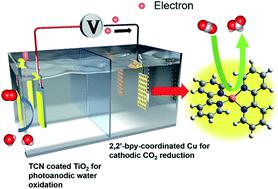当前位置:
X-MOL 学术
›
Sustain. Energy Fuels
›
论文详情
Our official English website, www.x-mol.net, welcomes your
feedback! (Note: you will need to create a separate account there.)
Photoelectrochemical conversion of CO2 into HCOOH using a polymeric carbon nitride photoanode and Cu cathode
Sustainable Energy & Fuels ( IF 5.0 ) Pub Date : 2020-09-15 , DOI: 10.1039/d0se01132k Yiwen Ma 1, 2, 3, 4, 5 , Yuanxing Fang 1, 2, 3, 4, 5 , Xianzhi Fu 1, 2, 3, 4, 5 , Xinchen Wang 1, 2, 3, 4, 5
Sustainable Energy & Fuels ( IF 5.0 ) Pub Date : 2020-09-15 , DOI: 10.1039/d0se01132k Yiwen Ma 1, 2, 3, 4, 5 , Yuanxing Fang 1, 2, 3, 4, 5 , Xianzhi Fu 1, 2, 3, 4, 5 , Xinchen Wang 1, 2, 3, 4, 5
Affiliation

|
A photoelectrocatalysis (PEC) system is developed for HCOOH production by the reduction of CO2 that is achieved by light illumination without any sacrificial agent. The photoanode is based on a polymeric carbon nitride semiconductor for water oxidation releasing electrons and protons to reduce CO2 on the cathode of Cu mesh coordinated with 2,2′-bipyridine. The Cu and 2,2′-bpy coordination promotes the adsorption of CO2 and the directional transport of electrons, thereby increasing the selectivity of HCOOH. In the two-electrode system, the photoelectrodes are wired with an external power supply to achieve a PEC system for sustainable production of HCOOH from atmospheric CO2 under ambient conditions. In this system, the performance of light-to-HCOOH can be preserved for least 16 hours, demonstrating the high stability of the conjugated polymers against photooxidation corrosion. This development offers opportunities for scaling up the application of fixation of CO2 using all sustainable materials.
中文翻译:

使用聚合氮化碳光阳极和铜阴极将CO2光电化学转化为HCOOH
开发了一种光电催化(PEC)系统,用于通过还原CO 2来生产HCOOH,该CO 2的还原是通过不使用任何牺牲剂的光照实现的。光电阳极基于聚合碳氮化物半导体,用于水氧化,释放出电子和质子,以还原与2,2'-联吡啶配位的Cu网格阴极上的CO 2。Cu和2,2'-bpy配位促进了CO 2的吸附和电子的定向传输,从而提高了HCOOH的选择性。在双电极系统中,将光电极与外部电源连接,以实现用于从大气CO 2可持续生产HCOOH的PEC系统在环境条件下。在该系统中,光到HCOOH的性能可以保留至少16小时,这表明共轭聚合物具有抗光氧化腐蚀的高稳定性。这一发展为使用所有可持续材料扩大CO 2固定应用的应用提供了机会。
更新日期:2020-10-07
中文翻译:

使用聚合氮化碳光阳极和铜阴极将CO2光电化学转化为HCOOH
开发了一种光电催化(PEC)系统,用于通过还原CO 2来生产HCOOH,该CO 2的还原是通过不使用任何牺牲剂的光照实现的。光电阳极基于聚合碳氮化物半导体,用于水氧化,释放出电子和质子,以还原与2,2'-联吡啶配位的Cu网格阴极上的CO 2。Cu和2,2'-bpy配位促进了CO 2的吸附和电子的定向传输,从而提高了HCOOH的选择性。在双电极系统中,将光电极与外部电源连接,以实现用于从大气CO 2可持续生产HCOOH的PEC系统在环境条件下。在该系统中,光到HCOOH的性能可以保留至少16小时,这表明共轭聚合物具有抗光氧化腐蚀的高稳定性。这一发展为使用所有可持续材料扩大CO 2固定应用的应用提供了机会。











































 京公网安备 11010802027423号
京公网安备 11010802027423号